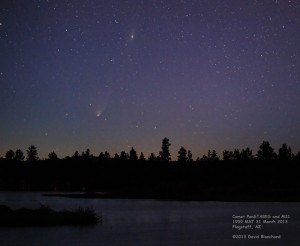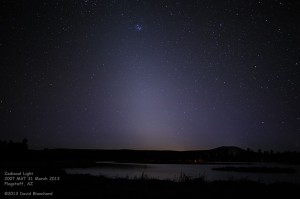The show continues with Comet C/2011 L4 (PanSTARRS) in the evening sky. Although it has grown dimmer — substantially so — in the past few weeks it is still easily visible in the northwestern twilight sky with a pair of binoculars. But it helps if you know exactly where to look.
For the next several nights, Comet PanSTARRS will be approaching M31 (also known as Andromeda Galaxy). Knowing where to find M31 it then becomes easy to look for the comet. Scanning the skies during twilight I was able to locate M31 with the binoculars then locked the position on the tripod. I swapped out the binoculars and replaced them with the camera.

Meanwhile, the zodiacal light has been quite remarkable this spring. This light is the result of the sun lighting up particles located in the ecliptic plane — the same plane in which the moon, sun, and planets move across the sky. The small size of many of the particles results in strong forward scattering so the brightest area is closest to the sun with the light fading above the horizon.

The zodiacal light was spectacular last night owing to exceptionally clear skies, no moon, and little or no nearby light pollution. After shooting the comet and M31 for some time I turned the camera more westward to capture this light. Sitting atop the triangle of light is the cluster of stars known as the Pleiades.
Over the next several evenings the comet will approach M31 so that they appear to overlap — although there is the mere distance of 2.5 million light years separating them.